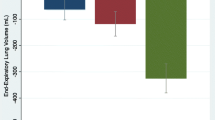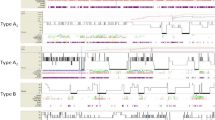Abstract
The maximal inspiratory effort recorded at the end of apnea has been considered as an index of arousal threshold in obstructive sleep apnea syndrome (OSAS). Previous investigations have shown that the arousal threshold is higher in patients with OSAS than in normal subjects. The aim of the present study was to investigate the effect of continuous positive airway pressure (CPAP) treatment on the inspiratory-effort-related arousal threshold in patients with OSAS. In ten male patients, 40 episodes of apnea during stage 2 non-REM (NREM) sleep were analyzed. Apnea duration (t), esophageal pressure (Pes) at the first occluded breath (Pes1), the minimum of the three initial Pes swings (Pes min), the maximum of the three final Pes swings (Pes Max), ΔPes (Pes Max−Pes min), RPes (rate of increase of intrathoracic pressure, ΔPes/t), n (number of occluded breaths during apnea), ΔPes/n, n/t, and SaO2 were determined before and after occlusion. These apneic episodes were compared to ten episodes of apnea provoked by a mask occlusion device after 1, 7, 30, and 90 days of CPAP treatment. The therapy resulted in a decrease in the inspiratory-effort-related arousal threshold, as measured by a reduction of Pes Max, without significant changes in apnea duration and apnea-related hypoxemia. Pes1 and ΔPes/n, which are markers of respiratory drive, significantly decreased between observations. CPAP treatment decreases the inspiratory-effort-related arousal threshold and induces a decrease in ventilatory drive in response to upper airway occlusion.



Similar content being viewed by others
References
Martin RJ, Pennock BE, Orr WC, Sanders MH, Rogers RM (1980) Respiratory mechanics and timing during sleep in occlusive sleep apnea. J Appl Physiol 48:432–437
Onal E, Leech JA, Lopata M (1985) Dynamics of respiratory drive and pressure during NREM sleep in patients with occlusive apnea. J Appl Physiol 58:1971–1974
Rees K, Spence DPS, Calverley PMA (1994) Pleural and transdiaphragmatic pressure swings during obstructive apneas in patients with OSA. Am J Respir Crit Care Med 149:A926
Phillipson EA, Sullivan CE (1978) Arousal: the forgotten response to respiratory stimuli. Am Rev Respir Dis 118:807–809
Remmers JE, deGroot WJ, Sauerland EK, Anch AM (1978) Pathogenesis of upper airway occlusion during sleep. J Appl Physiol 44:931–938
Berry RB, Bonnet MH, Light RW (1992) Effect of ethanol on the arousal response to airway occlusion during sleep in normal subjects. Am Rev Respir Dis 145:445–452
Scrima L, Broudy M, Nay KN, Cohn MA (1982) Increased severity of obstructive sleep apnea after bedtime alcohol ingestion: diagnostic potential and proposed mechanism of action. Sleep 5:318–328
Issa FG, Sullivan CE (1982) Alcohol, snoring and sleep apnea. J Neurol Neurosurg Psychiatry 45:353–359
Berry RB, McCasland CR, Light RW (1992) The effect of triazolam on the arousal response to airway occlusion during sleep in normal subjects. Am Rev Respir Dis 146:1256–1260
Berry RB, Kouchi K, Bower J, Prosise G, Light RW (1995) Triazolam in patients with obstructive sleep apnea. Am J Respir Crit Care Med 151:450–454
Guilleminault C, Rosekind M (1981) The arousal threshold: sleep deprivation, sleep fragmentation, and obstructive sleep apnea syndrome. Bull Eur Physiopathol Respir 17:341–349
Persson HE, Svanborg E (1996) Sleep deprivation worsens obstructive sleep apnea: comparison between diurnal and nocturnal polysomnography. Chest 109:645–650
Basner RC, Onal E, Carley DW, Stepanski EJ, Lopata M (1995) Effect of induced transient arousal on obstructive apnea duration. J Appl Physiol 78:1469–1476
Phillipson EA, Sullivan CE (1982) Ventilatory and arousal responses to hypoxia in sleeping humans. Am Rev Respir Dis 125:632–639
Ringler J, Basner RC, Shannon R, Manning H, Weinberger SE, Weiss JW (1990) Hypoxemia alone does not explain blood pressure elevations after obstructive apneas. J Appl Physiol 69:2143–2148
Berthon-Jones M, Sullivan CE (1984) Ventilation and arousal responses to hypercapnia in normal sleeping humans. J Appl Physiol 57:59–67
Douglas NJ, White DP, Weil JV, Pickett CK, Zwillich CW (1982b) Hypercapnic ventilatory response in sleeping adults. Am Rev Respir Dis 126:758–762
Vincken W, Guilleminault C, Silvestri L, Cosio M, Grassino A (1987) Inspiratory muscle activity as a trigger causing the airways to open in obstructive sleep apnea. Am Rev Respir Dis 135:372–377
Gleeson K, Zwillich CW, White DP (1989) Arousal from sleep in response to ventilatory stimuli occurs at a similar degree of ventilatory effort irrespective of the stimulus. Am Rev Respir Dis 142:295–300
Wilcox PG, Paré PD, Road JD, Fleetham JA (1990) Respiratory muscle function during obstructive sleep apnea. Am Rev Respir Dis 142:533–539
Kimoff RJ, Cheong TH, Olha AE, Charbonneau M, Levy RD, Cosio MG, Gottfried SB (1994) Mechanisms of apnea termination in obstructive sleep apnea. Role of chemoreceptor and mechanoreceptor stimuli. Am J Respir Crit Care Med 149:707–714
Gleeson K, Zwillich CW, White DP (1990) The influence of increasing ventilatory effort on arousal from sleep. Am Rev Respir Dis 142:295–300
Charbonneau M, Marin JM, Olha A, Kimoff RJ, Levy RD, Cosio MG (1994) Changes in obstructive sleep apnea characteristics through the night. Chest 106:1695–1701
Montserrat JM, Kosmas EN, Cosio MG, Kimoff RJ (1996) Mechanisms of apnea lengthening across the night in obstructive sleep apnea. Am J Respir Crit Care Med 154:993–995
Sforza E, Krieger J, Petiau C (1998) Nocturnal evolution of respiratory effort in obstructive sleep apnoea syndrome: influence on arousal threshold. Eur Respir 12:1257–1263
Berry RB, Kouchi KG, Der DE, Dickel MJ, Light RW (1996) Sleep apnea impairs the arousal response to airway occlusion. Chest 109:1490–1496
Carskadon MA, Dement WC, Mitler MM, Roth T, Westbrook PR, Keenan S (1986) Guidelines for the multiple sleep latency test (MSLT): a standard measure of sleepiness. Sleep 9:519–524
Johns MW (1991) A new method for measuring daytime sleepiness—the Epworth Sleepiness Scale. Sleep 14:540–545
Rechtschaffen A, Kales A (eds) (1968) A manual of standardized terminology, technique and scoring system for sleep stages of human sleep. Brain Information Service/Brain Research Institute, Los Angeles
ASDA (1999) Sleep-related breathing disorders in adults: recommendations for syndrome definition and measurement techniques in clinical research. Sleep 22(5):667–689
ASDA (1992) EEG arousals: scoring rules and examples. Sleep 15(2):174–184
Ryan T, Mlynczak S, Erickson T, Man SF, Man GC (1989) Oxygen consumption during sleep: influence of sleep stage and time of night. Sleep 12(3):201–210
Xi L, Smith CA, Saupe KW, Henderson KS, Dempsey JA (1993) Effects of rapid-eye-movement sleep on the apneic threshold in dogs. J Appl Physiol 75(3):1129–1139
Xi L, Chow CM, Smith CA, Dempsey JA (1994) Effects of REM sleep on the ventilatory response to airway occlusion in the dog. Sleep 17(8):674–687
Sforza E, J Krieger, W Bacon, Petiau C, Zamagni M, Boudewijns A (1995) Determinants of effective continuous positive airway pressure in obstructive sleep apnea. Role of respiratory effort. Am J Respir Crit Care Med 151:1852–1856
Downey R, Bonnet MH (1987) Performance during frequent sleep disruption. Sleep 10:354–363
Phillipson EA, Bowes G, Sullivan CE, Woolf GM (1980) The influence of sleep fragmentation on arousal and ventilatory responses to respiratory stimuli. Sleep 3:281–288
Fewell JE (1987) The effect of short-term sleep fragmentation produced by intense auditory stimuli on the arousal response to upper airway obstruction in lambs. J Dev Physiol 9:409–417
O’Donnell CP, King ED, Schwartz AR, Smith PL, Robotham JL (1994) Effect of sleep deprivation on responses to airway obstruction in the sleeping dog. J Appl Physiol 77:1811–1818
Wiegaud L, Zwillich C, White D (1988) Sleep and the ventilatory response to resistive loading in normal man. J Appl Physiol 64:1186–1195
Chen Z, Eldridge FL, Wagner PG (1991) Respiratory associated rhythmic firing of midbrain neurons in cats: relation to level of respiratory drive. J Physiol 437:305–325
Svanborg E, Larson H (1993) Development of nocturnal respiratory disturbance in untreated patients with obstructive sleep apnea syndrome. Chest 104:340–343
Pendlebury ST, Pépin JL, Veale D, Levy P (1997) Natural evolution of moderate sleep apnoea syndrome: significant progression over a mean of 17 months. Thorax 52:872–878
Lugaresi E, Cirignotta F, Gerardi R, Montagna P (1990) Snoring and sleep apnea: natural history of heavy snorers disease. In: Guilleminault C, Partinen M (eds) Obstructive sleep apnea syndrome: clinical research and treatment. Raven, New York, pp 25–36
Berry RB, Asyali MA, McNellis MI, Khoo MC (1998) Within-night variation in respiratory effort preceding apnea termination and EEG delta power in sleep apnea. J Appl Physiol 85(4):1434–1441
Acknowledgements
This work was supported by a grant from the French Ministry of Health (PHRC97 no. 1876).
Author information
Authors and Affiliations
Corresponding author
Rights and permissions
About this article
Cite this article
Haba-Rubio, J., Sforza, E., Weiss, T. et al. Effect of CPAP treatment on inspiratory arousal threshold during NREM sleep in OSAS. Sleep Breath 9, 12–19 (2005). https://doi.org/10.1007/s11325-005-0002-5
Published:
Issue Date:
DOI: https://doi.org/10.1007/s11325-005-0002-5




